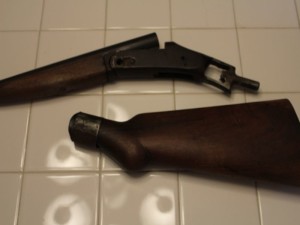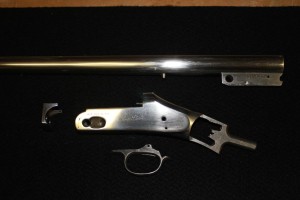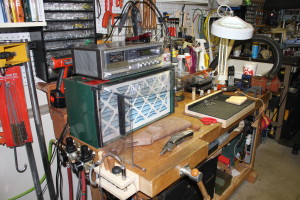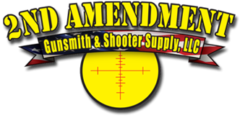Over the years, as a gunsmith, I’ve acquired and inherited numerous old guns and have just placed them in the back of the gun safe thinking that someday I’ll get around to cleaning them up or restoring them. Being a gunsmith is like any other profession where the customer’s job comes first and those old guns just accumulated over the years.
I’m an old school gunsmith. I grew up working on guns with my uncle who loved the Colonial and Revolutionary period. As a result, I learned the art & craft of the gunsmith over the modern day production line gunsmith. I love to watch the YouTube videos of gunsmiths that really get down and dirty, right into the heart of a gun to fix those really tough problems. These folks are not the big box store variety gunsmith. They are the true craftsmen of the profession.
A few months ago when I discovered that I didn’t have any more room for more old guns I decided to clean out the old gun safe and get rid of those guns that I really didn’t need. Of course, my wife was really happy at the prospect of reclaiming some storage space. However, as with any gunsmith, looking at those old guns recalls history and a story that just shouldn’t be destroyed.
 At that point, I decided to start on a new campaign of cleaning and restoring them in what little spare time I have.
At that point, I decided to start on a new campaign of cleaning and restoring them in what little spare time I have.
I chose an H&R 1901 Baystate single barrel 12 gauge shotgun as my first restoration project. This shotgun came to me 10 years ago with the passing of a family member. The condition of the shotgun was quite pitiful to say the lease.
The receiver pivot pin is missing, all of the metal parts are severely rusted and corroded from long use without cleaning, the bore of the barrel is pitted and rusted, the firing pin is cracked, and the stock is split in so many places a metal band had been fabricated to hold it together at the grip.
 When disassembling an old weapon of any type great care must be taken so as not to break any of the parts. In many cases, parts for older weapons are brittle and not easy to find. Many gunsmiths will spend a lot of time researching the Internet for old part sources. Parts for newer mode weapons are easy to find by simply calling the manufacturer. In the case of this Harrington & Richardson Baystate circa 1900 single barrel shotgun, the original H & R company is no longer in existence. Therefore, you must be creative to find a reliable parts source.
When disassembling an old weapon of any type great care must be taken so as not to break any of the parts. In many cases, parts for older weapons are brittle and not easy to find. Many gunsmiths will spend a lot of time researching the Internet for old part sources. Parts for newer mode weapons are easy to find by simply calling the manufacturer. In the case of this Harrington & Richardson Baystate circa 1900 single barrel shotgun, the original H & R company is no longer in existence. Therefore, you must be creative to find a reliable parts source.
Sometimes, parts from a more recent model weapon are interchangeable with little or no modification. In this case, I was able to find the Frame Pivot pin from a newer model 148 and grind the head down to make it fit flush with the Receiver.
 Once all of the parts were disassembled they were first washed in a degreaser then flushed with warm water and dried thoroughly.
Once all of the parts were disassembled they were first washed in a degreaser then flushed with warm water and dried thoroughly.
A close inspection showed extensive rust underling the bluing; especially around the edges of the forestock. A fine metal file had to be used to remove the rust around the forestock. Emery cloth in grits of 80, 120, and 240 was progressively used to remove the bluing and rust pitting. It was followed with a 500 grit to bring the metal up to a fine polish. Typically, a fine polish is not needed before re-bluing, but I wanted to ensure that all of the very small and very deep rust pits were completely removed. As you can see in the picture to the right, a lot of long hours in sanding and polishing resulted uncovering a magnificent old shotgun.
 Before I go into the details of this restoration we should take a look at the workshop so that you’ll see that it takes a good work area and good tools to work on firearms properly.
Before I go into the details of this restoration we should take a look at the workshop so that you’ll see that it takes a good work area and good tools to work on firearms properly.
In addition to the workbench, the shop needs compressed air with various regulators for different tools that require different pressure levels, air scrubber to capture dust and various types of airborne particles, shop vacuum, bench vise, drill press, a hefty assortment of tools, and a shop sink.
Additionally, safety first is the rule in any workshop. You’ll need a breathing mask, safety glasses, disposable gloves, and an emergency power cutoff. Also, the shop sink can be used in case you get sawdust, dirt, or chemicals on your skin plus it can be used as an eye-wash station should you accidentally get anything in your eyes. Remember to keep a phone nearby in case you need to call for emergency services should you have an accident and need a paramedic.
Keep in mind that you need to keep your workplace clean and orderly, therefore, you should clean up your mess as you go. Otherwise, you’ll find that some of the smallest parts that you’ve set aside for cleaning and reassembly have disappeared in the rubble.
Lastly, a workshop is no place for small children. It is full of hazards, therefore, children should be kept at a distance and under constant supervision until they are of an age where they can be taught the proper safety measures and proper usage of its tools. My uncle first introduced me to his gunsmith shop when I was 7 years old and I spent many hours and years learning the craft at his side.


More of a question,I have a double barrel shotgun gauge.need it restored,I live in ft.worth,Texas,cannot find an address,for one of your stores here,please help me,have heard some great things about you all,thanks.louis.a..juarez.oh,my gun is a 16gauge .
Good day how do I reach this person to sell some guns
Hello .i would like to know if you do release triggers on Browning 725 unsingle trap gun if so what is your price and turn around time thank you